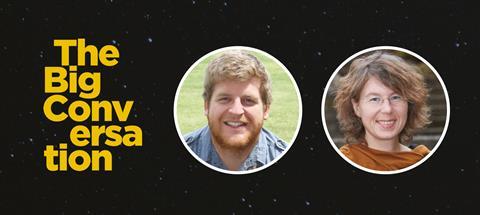Theoretical astrophysicist Luke Barnes explains how he changed his mind on the age of the universe
In early 2002, I caught the train to a small office building in Sydney. I was 18 and starting an undergraduate degree in physics at the University of Sydney. I’d sent an email to a well-known young earth creation ministry explaining that I was going to talk to a professor about a first-year research project on Big Bang cosmology. Did they have any resources that would help me defend a 6,000 year-old universe?
At their office, an enthusiastic lady handed me a large folder: “We were so excited by your email!” she said. Someone, who has my eternal gratitude, had painstakingly photocopied every article and book chapter they could find that ‘debunked’ the Big Bang theory. I said thank you, squeezed it into my backpack and walked back to the station. On the train, I started reading. A few weeks later, I went to see the professor.
DEBUNKING SCIENCE
I grew up in a church in which the default position was young earth creationism (YEC): the view that the Bible teaches and science (properly done) shows that the universe was created around 6,000 years ago. Not everyone subscribed to this idea. The local high school science teacher would challenge the pastor (my father) with the evidence for evolution. But most of the church would cheerfully attend meetings hosting visiting YEC speakers.
These speakers impressed me, not just with their knowledge but with the impression that they knew more than the ‘experts’. A budding dinosaur nerd, I could recognise a brontosaurus; they could tell me that it never existed (wrong fossil head on the wrong body – these scientists are wrong all the time, you see). I listened to their talks, watched their videos and read their books and magazines.
I was taught that while science is good, it has to make questionable assumptions in order to say anything about the past. The apparent conflict between the Bible and science is really a conflict between the Bible and these assumptions. Moreover, many non-believers, because of their unthinking acceptance of modern science, dismiss the Bible out of hand. Why read about Jesus when the first chapter is all wrong?
With this background, the thought of sharing my faith with anyone – particularly at university – was daunting. There was so much to debunk first: radioisotope dating methods, supposed transitional fossils, the Miller–Urey experiment, most of geology, the peppered moth, ice cores, Piltdown man and so on.
Clearly, I needed that folder.
LEARNING THE BASICS
My professor’s name was Richard ‘Dick’ Hunstead. Dick was a highly respected astronomer and a well-loved teacher. I would get to know him as his student and later as a fellow scientist. In our first meeting, I was ready with an idea from the folder: an astronomer called Halton Arp had discovered some strange galaxies that seemed to challenge the Big Bang theory. Could I take a closer look?
Dick astutely noted that it was a tad premature to start challenging the Big Bang: it hadn’t been covered in lectures yet. He directed me to simply learn about cosmology, and in particular, something called the cosmic microwave background (CMB). I was given some popular-level articles and discovered the physics library.
I was soon taken aback. It wasn’t that I discovered that these cosmologists had been right all along, or had mind-blowing evidence to support their claims. The real shock was learning, for the first time, what the Big Bang theory actually was. I don’t mean that I uncovered the real, secret, scandalous truth. I mean, I learned the basics.
Despite all those magazines and books and videos and talks, I couldn’t have actually described the Big Bang theory. It was an embarrassing realisation. When Dick mentioned the CMB, I remembered having seen that term in the folder, multiple times. But when Dick asked if I knew what it was, I couldn’t tell him. I didn’t know.
That thread, once pulled, unravelled a lot. Creationists had portrayed the Big Bang theory as complicated, convoluted and crazy; I was stunned by its simplicity. It wasn’t long before I knew enough to see that many ‘debunkings’ in the folder failed: strawman logic, faulty physics, bad astronomy. Much of the rhetoric was guilt by association: if they’re wrong about the brontosaurus, why not this? But whenever I looked more deeply, the criticism evaporated. Again and again, I was left with nothing.
UNSOLVED
If you’re prepared to dive into some details, here’s one example:
“The problem of explaining the existence of galaxies has proved to be one of the thorniest in cosmology”, says physicist Dr James Trefil. This quote was presented in books by young earth advocates as a disastrous admission of an unfillable hole in the Big Bang theory.
But among cosmologists, I found a very different attitude. Yes, there was a genuine puzzle when it came to galaxy formation. How had the almost perfectly uniform expansion of the universe allowed matter to clump together fast enough to form stars and galaxies?
Admittedly, when Trefil made his statement in 1988, nobody was sure of the answer. Seminal papers in galaxy formation theory were still being written. Large-scale galaxy surveys were a decade away. Computer simulations were just beginning to be explored. But far from being hidden, problems were openly embraced. Trefil’s statement wasn’t overheard on a wiretap or blurted out under cross-examination; it was published.
Why think that galaxy formation is unsolvable, rather than merely unsolved? When I began to engage with the evidence in the early 2000s, I read in a YEC book of a challenge to Big Bang theory. It promised that a mathematical proof had been found which rendered galaxy formation impossible in Big Bang cosmology.
THE HARDER I LOOK, THE MORE OF GOD’S HANDIWORK I SEE
It didn’t take me long to track down the original paper, written in 1977. I found that the mathematical result was not a secret – it had also been derived in 1966 by Stephen Hawking and could be found in most cosmology textbooks. And, like all mathematical proofs, it had terms and conditions. Hawking had already suggested in 1966 that one of the conditions may be false and, by 1992, observations of the CMB had confirmed that he was right. In short, the first moments of the universe were lumpier than had previously been thought, providing the seeds of later galaxies.
Thousands of papers have been published in the field in recent decades, including analyses of deep observational galaxy surveys and massive supercomputer simulations. Yet that same YEC book in 1999 had claimed that “there are few researchers left in the field” pursuing answers to galaxy formation. I knew this was false when I read it in 2002; reading it again today, it is flabbergasting.
This is just one example. The rest of the folder’s objections to modern astrophysics – the speed of light, white hole cosmologies, rotating universes, supernova remnants, quantised redshifts, star formation, population III stars – couldn’t withstand scrutiny either.
The study of galaxy formation continues. Puzzles remain. The universe is a complicated place, not a Rubik’s cube that we’ve solved. I’m not saying that we know everything now. Yet it seemed to me that where the mainstream scientific community adopted an attitude of open inquiry, the YEC literature seized on any open problem or anomaly and announced it to be unsolvable and catastrophic. I had to discover the full picture for myself.
DEFENDING CHRISTIANITY
You might think that this is the story of a crisis of faith. It is not.
At the same time as I was evaluating my young earth beliefs, I was devouring books on history and philosophy. I spotted a book called The Ways of an Atheist (Prometheus Books) in a bookstore and bought it; it turned out to be one logical non sequitur after another. I thought maybe I needed a better class of atheist, so I bought Bertrand Russell’s Why I Am Not a Christian (Touchstone), but wasn’t impressed by that either. I sought out books by critics, listened to lectures and debates. Christian Bible scholars, historians and philosophers could meet secular attacks and convincingly hold their ground. Young earth creationists couldn’t.
In my reading, I came across the idea that the existence of life in our universe requires astounding coincidences in the fundamental laws of physics. This wasn’t attacking science; it was using science to see deeper into God’s good order in nature. As a PhD student in astronomy at the University of Cambridge, I looked deeper. This time, I found extensive, detailed and compelling technical literature, written by highly respected physicists, both secular and Christian.
I read everything. I wrote popular-level articles. I published a review paper. I saw opportunities for research. I won grants. I collaborated with world-leading cosmologists. I ran supercomputer simulations of galaxy formation. I presented at scientific conferences. I co-wrote a book for Cambridge University Press. This fine-tuning of the universe for life has become the focus of my career as an astrophysicist.
Here, finally, the harder I look, the more of God’s handiwork I see. I can understand design while appreciating the designer. Science discovers and describes the internal logic of God’s creation. Science raises questions that are too big for science. To the curious, nature points beyond itself, raising questions of order and existence that are best explained by a divine mind.
RE-READING GENESIS
But what about Genesis? What is it trying to teach? This sent me (again) to read everything I could find. Reopening the folder today (yes, I still have it), I find photocopies of Hebrew lectionaries and Bible commentaries from my father’s study, articles on archaeology, passages from Church fathers, philosophy of science and more. At the time, I spent a few months trying to organise my thoughts in one epic Word document. I didn’t reach many firm conclusions then, and not much has changed.
What I do believe is that Genesis was written for us, but it wasn’t written to us (to borrow a quote from theologian John Walton).
It was written for us – to teach us about God, creation and ourselves. God is the sovereign creator. He is good, powerful, rational and without equal. The physical universe is his purposeful creation, charged with meaning, rationality and order. We are created in God’s image, able to think, act for good or evil and appreciate God’s manifest beauty in his world.
It was also written to a specific people, in a specific culture, at a specific time. So, how did it teach them about God, creation and themselves? By giving a historical account of real events or by using a memorable, polemical parable?
Given that they couldn’t have known the difference, that the lesson is the same regardless, and that the lesson might be made more clearly by a parable, I think that we can’t decide from the passage alone. We instead look to observations of the universe for an answer. God has given us the book of scripture and the book of nature. They must each be read carefully.
In the end, I’m an astrophysicist, not a theologian. I’m still learning. But I’m embracing the puzzles. And if someone could photocopy a bunch of articles about the ancient Near East and put it in a folder for me, that would be really helpful…
THE BIG CONVERSATION: WAS THE COSMOS MADE FOR US?

The ‘fine-tuning’ of the Universe for life remains one of the most remarkable findings of modern cosmology. Most of the fundamental forces of our universe must take a precise value in order for the cosmos to be able to produce life.
But does the scientific evidence of ‘fine tuning’ point to a maker beyond the universe? Christian astrophysicist Luke Barnes and atheist physicist Sabine Hossenfelder debate the question in this edited excerpt from The Big Conversation.
Sabine Hossenfelder: I would say that the question raised by fine tuning is not a scientific question. You can certainly ask for an explanation - you can call it philosophical reasoning, or maybe religious reasoning. But it won’t be a scientific explanation.
Justin Brierley: Luke, do you think it’s a legitimate scientific question to ask: Where does the universe come from?
Luke Barnes: Well, let me shock the audience… and say ‘no’. It’s not a scientific question. It is a philosophical question. I totally agree.
However, if you think that the only good questions are scientific questions, then I’d want to know why you think that. Because even the question, ‘Why are all good questions scientific questions?’ is actually a philosophical question!
I don’t want to replace science with God. That’s not the point. What matters is the possibility of a better explanation. You still have a whole bunch of questions like: Why is there a universe at all? Why is there a universe in which life can exist?
They’re not scientific questions, because science can’t answer them. So what do we do with them? We either throw them out - you could call that ‘naturalism’. Or the other option is to look at the sort of things that might be able to explain it.
The theistic answer to the fine tuning is that there is the possibility of a better explanation. It is the way it is for a reason.
JB: Do these deeper questions interest you Sabine?
SH: If you ask me personally, no. It doesn’t interest me very much. My concern is to tell physicists when they cross the border, from science to philosophy or religion.
Watch Luke and Sabine in full at thebigconversation.show/finetuning
Read a response to this article by Jim Mason, ‘Why I’m finally a young earth creationist’


































